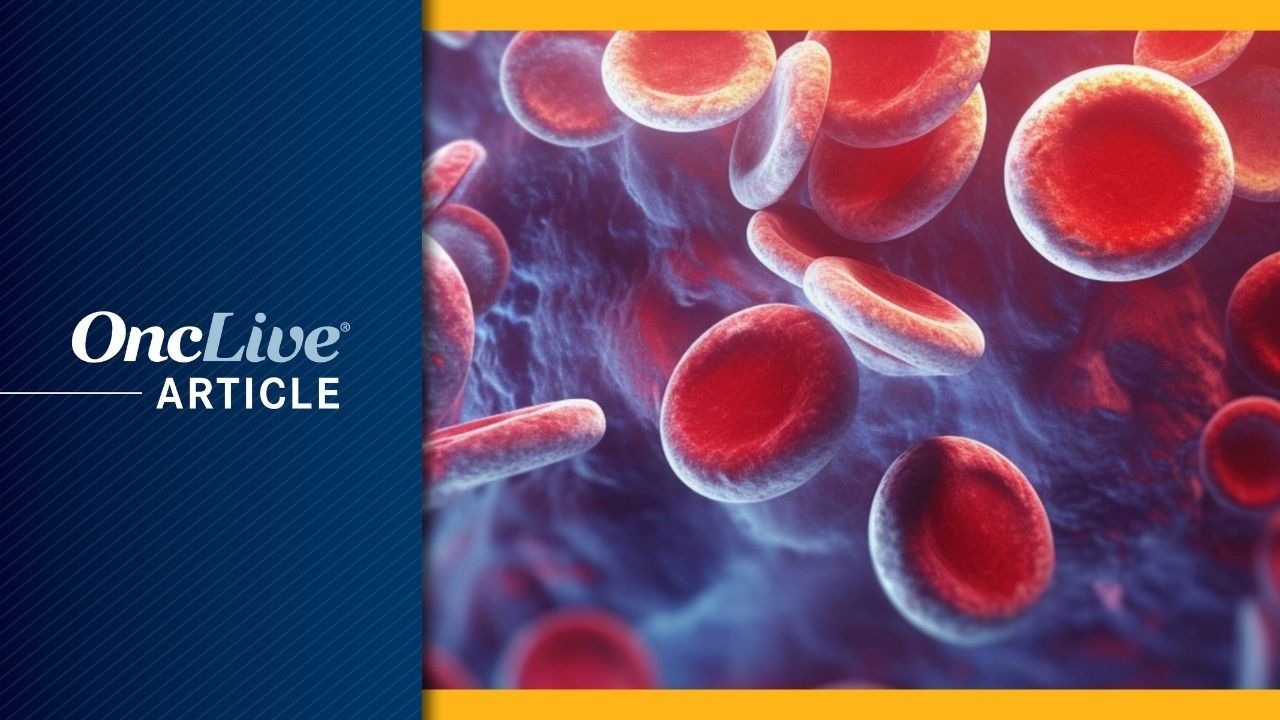Treatment with BTK inhibitors in patients with chronic lymphocytic leukemia (CLL) harboring NOTCH1 mutations was associated with significantly longer progression-free survival (PFS) compared with chemoimmunotherapy, according to findings from a retrospective analysis published in eJHaem.1
In the NOTCH1-mutated subgroup, the median PFS was not reached with BTK inhibitor treatment compared with 50.6 months with chemoimmunotherapy (HR, 10.86; 95% CI, 1.37-85.88; P = .005). However, no significant difference in overall survival was observed between the arms (P = .22).
These findings suggest that BTK inhibitor therapy may mitigate the adverse prognostic effect of NOTCH1 mutations in CLL. Similar observations were previously reported in the randomized phase 3 RESONATE trial (NCT01578707), in which patients with NOTCH1-mutated disease experienced inferior PFS with ofatumumab (Kesimpta) compared with ibrutinib (Imbruvica).2 Preclinical data also indicate that BTK inhibition reduces NOTCH1 activation through disruption of B-cell receptor/NOTCH1 crosstalk, providing a biological rationale for the observed clinical benefit.3
Retrospective Study of the Effects of NOTCH1 Mutation Status on Treatment Efficacy in CLL: Key Points
- Treatment with BTK inhibitors resulted in a significantly longer median PFSin patients with CLL harboring NOTCH1 mutations compared with treatment with chemoimmunotherapy.
- These findings suggest that BTK inhibitor therapy may mitigate the adverse prognostic effect of NOTCH1 mutations in CLL, possibly by disrupting B-cell receptor/NOTCH1 crosstalk.
- The study highlights the potential value of screening for NOTCH1 mutations to identify patients with CLL who may benefit from BTK inhibitor treatment.
In contrast, among patients without NOTCH1 mutations, the retrospective analysis showed no significant difference in PFS between those treated with BTK inhibitors vs chemoimmunotherapy (P = .51).1 In the BTK inhibitor–treated population, the estimated 2-year PFS rates were 94% for patients with NOTCH1 mutations vs 84% for those without NOTCH1 mutations (P = .12). No significant survival differences were observed between subgroups with mutated vs unmutated disease treated with chemoimmunotherapy (P = .14). These findings are consistent with prior data from studies like the phase 3 LRF CLL4 trial (NCT58585610) and an analysis of the predictive value of NOTCH1 mutations, which both identified NOTCH1 mutations as independent adverse prognostic markers in the context of chemoimmunotherapy in patients with CLL.
“In addition to routine TP53 and IGHV mutation status, our study highlights the potential value of screening for NOTCH1 mutations to identify patients who may benefit from BTK inhibitor treatment,” lead study author Clémence Haméon, MD, of the Hematology and Cell Therapy Department of Tours University Hospital at Tours Centre Val de Loire in France, and coauthors wrote in the paper. “The [effect] of NOTCH1 mutations on combination therapies, such as obinutuzumab [(Gazyva) plus] venetoclax [Venclexta] or venetoclax [plus a] BTK inhibitor, is yet to be determined.”
Among 229 eligible patients screened, 174 were included in the analysis. The median age at diagnosis was 63 years, and the median follow-up duration was 84.1 months. At baseline, most patients presented with early-stage disease, with 66.1% of patients classified as having Binet stage A disease, 25.3% of patients classified with stage B disease, and 8.6% of patients classified with stage C disease.
Regarding immunogenetic features, 84 patients (48.3%) had unmutated IGHV, 62 patients (35.6%) had mutated IGHV, and 28 patients (16.1%) had unknown IGHV mutational status. A complex karyotype was identified in 34 of 170 evaluable patients (20%). Fluorescence in situ hybridization analysis demonstrated 17p deletions in 6.0% of 168 evaluable patients and 11q deletions in 12.4% of 169 evaluable patients.
NOTCH1 mutations were detected in 25.9% of all patients prior to initiation of first-line therapy. The most frequent alteration was a c.7541_7542 deletion in exon 34, observed in 64.4% of NOTCH1-mutated cases. Patients with a NOTCH1 mutation were more likely to be older than 65 years and to harbor unmutated IGHV, with statistically significant associations observed for both factors (P = .007 and P = .002, respectively). No significant associations were identified between NOTCH1 mutation status and gender, Binet stage, complex karyotype, or TP53 mutation status.
The median time from diagnosis to first treatment was shorter in patients with a NOTCH1 mutation compared with those without (21.75 months vs 45.9 months, respectively; P = .06).
First-line treatment patterns among patients with NOTCH1 mutations were diverse. Chemoimmunotherapy was administered to 15 patients, most commonly fludarabine plus cyclophosphamide and rituximab (Rituxan; n = 8), followed by bendamustine plus rituximab (n = 5) and dexamethasone plus rituximab and cyclophosphamide (n = 2). A total of 18 patients received BTK inhibitors, including ibrutinib (n = 10) and acalabrutinib (Calquence; n = 8). Additional therapies included obinutuzumab plus venetoclax (n = 2), chloraminophene (n = 3), acalabrutinib (n = 3), venetoclax monotherapy (n = 2), and other regimens (n = 2).
References
- Haméon C, Houot R, Gyan E, et al. NOTCH1 mutation is associated with response to Bruton tyrosine kinase inhibitors in chronic lymphocytic leukemia: a retrospective study. eJHaem. 2025;6(5). doi:10.1002/jha2.70146
- Munir T, Brown JR, O’Brien S, et al. Final analysis from RESONATE: up to six years of follow-up on ibrutinib in patients with previously treated chronic lymphocytic leukemia or small lymphocytic lymphoma. Am J Hematol. 2019;94(12):1353-1363. doi:10.1002/ajh.25638
- Del Papa B, Baldoni S, Dorillo E, et al. Decreased NOTCH1 activation correlates with response to ibrutinib in chronic lymphocytic leukemia. Clin Cancer Res. 2019;25(24):7540-7553. doi:10.1158/1078-0432.CCR-19-1009
